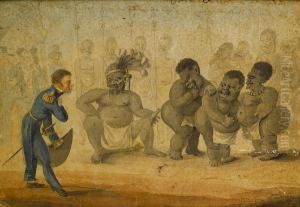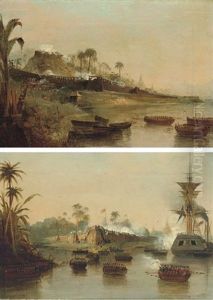Frederick Marryat Paintings
Captain Frederick Marryat was a British Royal Navy officer, novelist, and an early pioneer of the sea story genre, born on July 10, 1792, in London, England. Marryat's career in the navy began at a young age, and he served during the Napoleonic Wars, experiencing firsthand the life at sea that would later inspire his writing. He achieved the rank of captain in 1815, after which his naval career continued to flourish, providing him with a wealth of experiences that he would draw upon in his later literary works.
Marryat's decision to start writing was partly influenced by his naval career and his desire to document the lives of sailors and the adventures that were part of the naval experience. In 1829, he published his first novel, "The Naval Officer," which was loosely based on his own experiences. This marked the beginning of a prolific writing period, during which he produced some of his most famous works, including "Mr. Midshipman Easy" (1836) and "Peter Simple" (1834). Marryat's novels were known for their humor, vivid descriptions of naval life, and their pioneering role in developing the nautical adventure genre.
Beyond his contributions to literature, Marryat also made significant contributions to nautical technology and was instrumental in the development of the Marryat Code, a system of maritime flag signaling that was widely adopted in the 19th century. After retiring from the navy in 1830, he devoted himself entirely to writing and spent the latter part of his life in Norfolk, where he continued to write until his death on August 9, 1848.
Marryat's legacy endures through his novels, which remain in print and have inspired generations of writers and readers fascinated by the sea. His work provides a valuable insight into the life at sea during the early 19th century, capturing the essence of naval adventure with authenticity and unparalleled realism. Marryat is remembered not only as a pioneer of the sea story but also as a significant figure in the development of English literature in the 19th century.

